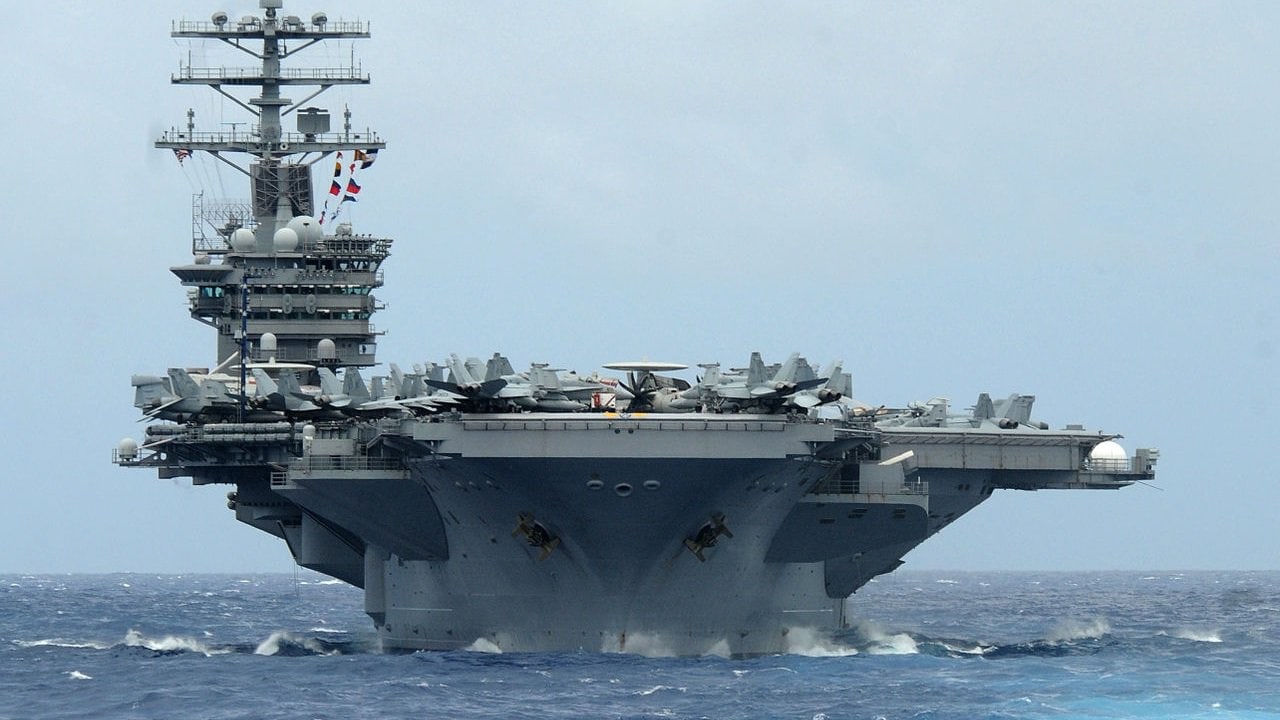USS Nimitz – the Aircraft Carrier designed for a Cold War Turned Hot Against Russia – The popular T-shirt slogan, “I’m not old, I’m a classic,” could be a fitting second motto for the United States Navy’s USS Nimitz (CVN-68), which currently has the distinction of being the oldest nuclear-powered aircraft carrier in service today. With the final decommissioning of the USS Enterprise (CVN-65) on Feb. 3, 2017, Nimitz also became the oldest active aircraft carrier in the U.S. Navy.
(Subscribe to Our YouTube Channel Here. 19FortyFive publishes original videos every day.)
More importantly, she is the lead vessel of what has arguably proven to be the most crucial class of warships ever built.
Meet the “Old Salt”
Named after Fleet Admiral Chester W. Nimitz, the United States Navy’s last “five-star” admiral, the keel of the USS Nimitz was laid on June 22, 1968. Catherine Nimitz Lay, daughter of the late World War II admiral, christened the aircraft carrier on May 3, 1975. Then-President Gerald R. Ford was the principal speaker at the commissioning ceremony.
“I see this great ship as a double symbol of today’s challenging times,” Ford said. “Whether her mission is one of defense, diplomacy or humanity, the Nimitz will command awe and admiration from some, caution and circumspection from others, and respect from all.”
It is hard not to respect the massive warship.
At 1,092 feet, and displacing some 102,000 tons, the Nimitz-class supercarriers are more than three times the length of a football field, and with a crew of 3,200 sailors and 2,480 airmen, each is essentially a floating airbase that can play an important role in modern power projection. The nuclear-powered carriers, which have two reactors and four shafts for propulsion, can reach a top speed of 30+ knots (34.5mph).
The supercarriers have an expected 50-year service life with one mid-life refueling. In addition, modern flattops were designed to withstand three times the damage sustained by the Essex-class aircraft carriers inflicted by Japanese air attacks during World War II. This included hangars on the ships that were divided into three fire bays by thick steel doors that are designed to restrict the spread of fire.
Power Projection
As a floating airbase, USS Nimitz is typically embarked with approximately 60 aircraft, including a variety of fixed-wing and rotary-wing aircraft with up to 90 of various types. The aircraft now include 12 F/A-18E/F Super Hornets, 36 F/A-18 Hornets, four E-2C Hawkeyes, and four EA-6B Prowlers fixed-wing and helicopters, including four SH-60F and two HH-60H Seahawks. In addition, the carriers could also deploy the S-3B Viking, before these were phased out and replaced by the F/A-18E/F Super Hornet.
The flight deck, which measures 1,092 feet by 252 feet, is equipped with four lifts, four steam-driven catapults and four arrester wires. The carrier is capable of launching one aircraft every 20 seconds.
Service History
CVN-68 had been deployed to the Indian Ocean in response to the Iran hostage crisis. However, the ill-fated Operation Evening Light rescue mission, which saw the aircraft launched from the carrier’s deck, was aborted after a helicopter crashed at a refueling point in the Iranian desert.
Throughout the 1980s, she was regularly deployed around the world, and in 1988 provided security off the coast of South Korea during the Olympic Games in Seoul. In 2003, during her eleventh operational deployment, Nimitz took part in Operation Iraqi Freedom launching Carrier Air Wing 11 aircraft over 11, and over Afghanistan in support of Operation Enduring Freedom.
In 2005, the USS Nimitz commemorated 30 years of service. Film crews spent an entire deployment on board for the PBS documentary Carrier, which provided an intimate look at life aboard the ship.
During the vessel’s 2017 deployment, elements of her airwing took part in combat operations against ISIS in Iraq and Syria, followed by a period in overhaul. The old warship is set to be retired in 2025.
Yet, her role in the Cold War and the rapidly changing world that followed can’t be overstated. As President Ford said more than 45 years ago, “Wherever the United States Ship Nimitz shows her flag, she will be seen as we see her now—a solid symbol of United States strength, United States resolve—made in America and manned by Americans.”
MORE: Donald Trump Just Destroyed His 2024 Changes
MORE: The F-15EX Is No F-35
MORE: The One GOP Candidate Worse Than Donald Trump
Now a Senior Editor for 1945, Peter Suciu is a Michigan-based writer who has contributed to more than four dozen magazines, newspapers and websites. He regularly writes about military hardware, firearms history, cybersecurity and international affairs. Peter is also a Contributing Writer for Forbes.

